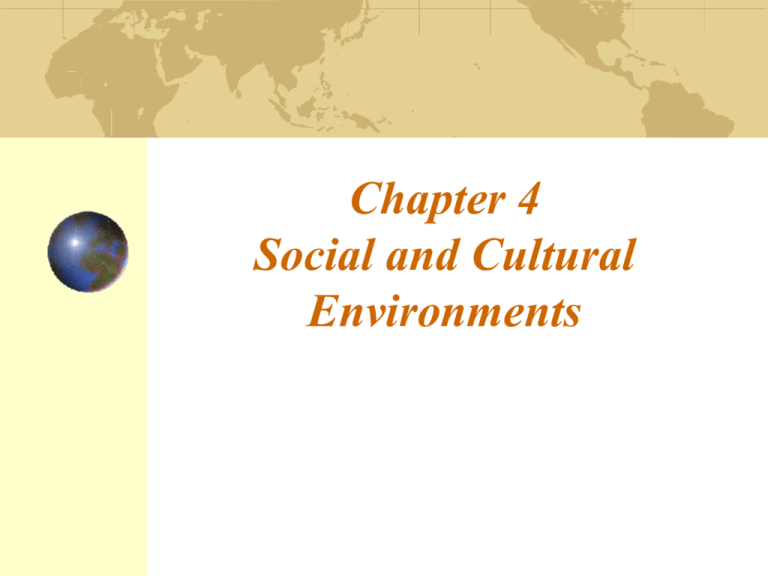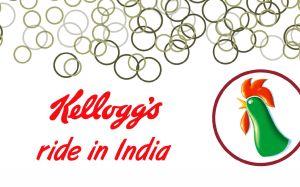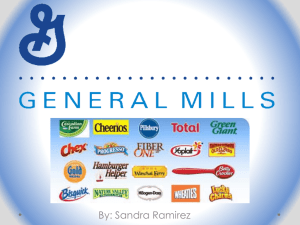Chapter 4 Social and Cultural Environments
advertisement

Chapter 4 Social and Cultural Environments Introduction This can happen to anyone, anywhere, at anytime if you don’t understand other people’s culture. Finn Hansen Hansen, head of international operations at Arla Foods, referring to the boycott of Danish products by Muslims and the political debacle that followed the publication of images of the prophet Mohammed in a Danish newspaper. http://www.timesonline.co.uk/tol/news/world/europe/ar ticle723266.ece 4-2 Culture and marketing Some ways of living are unique to culture (e.g. prom; going away to college) Some ways of living are common across cultures (e.g. celebrating births, marriages, etc.) Rapid inter-connectedness means shared ways of living increase Global consumer cultures (credit-card culture, pub culture, coffee culture, fast-food culture, etc.) Primarily embodied in the global teenager Rapid interconnectedness means that resistance to imported cultures also increases Cargill seeds, KFC in India, McDonalds in France, American fast food 4-3 Culture and marketing Find which aspects of culture does your product / brand impact Are these aspects shared / unique Shared aspects: standardized marketing programs Unique aspects: Adapted marketing programs Which products are impacted by GCC? 4-4 4-5 Breakfast habits in India Breakfast habits Indians like to eat hot, sit-down breakfasts Milk generally comes in fresh every morning. Needs to be heated before consumption Rice preparations in the south, wheat and corn preparations in the north Are used to and prefer spicier foods, not sweet Drink hot tea with milk and sugar with breakfast Oats are for horses Often eat with their fingers – may use a spoon 4-6 Kellogg’s breakfast cereals in India - Product What should Kellogg’s adapt and what should they standardize? Product • • • • • Cornflakes (as in the US) Wheat flakes and rice flakes cereals Suitable for warm milk Unsweetened Cereal bars Packaging • Weight in grams (metric) 4-7 Kellogg’s breakfast cereals in India - Price Premium pricing Cornflakes Rs. 130 for 475 gms. i.e. $2.75 for 16 ounces of cornflakes. US price: 12 ounces - $3. Average cost of an Indian breakfast – Rs. 20, i.e. $0.40 Why premium pricing? ‘premium’ image associated with Western foods 4-8 Kellogg’s breakfast cereals in India - Place Most retailers are small shopkeepers; large grocery stores are few and concentrated in urban areas Cereals mainly available in large cities Wholesaler Retailer chain used 4-9 Kellogg’s breakfast cereals in India - Promotion Cereal bars – positioned as an anytime snack – placed in the candy aisle in a grocery store Cereals http://www.youtube.com/watch?v=uoDwJT_ZP-M&NR=1 http://www.youtube.com/watch?v=uSXHOPe1eE&p=7DB7C4654547C017&playnext=1&index=28 Kellogg’s US ads http://www.youtube.com/watch?v=CtPTrG0DxXY http://www.youtube.com/watch?v=5Id3yJ8Qalo&feature=relate d 4-10 4-11 Clothes washing in India • Daily, by hand (belief that clothes do not come out clean unless properly scrubbed) • Maid • Hang them out to dry • Sturdy white (males) and colorful (females) cottons • Power is expensive • Living space is at a premium • Water is scarce • Greater foaming = greater cleaning power • Clothes become dirty faster in dusty, hot climates 4-12 P & G’s detergents in India Product The Tide Bar Price 125 gm (7 ounces) bar is Rs. 7 ($0.15) - inexpensive Place Everywhere (incl. small villages) – mass distribution Promotion http://www.youtube.com/w atch?v=RWALQ-EmRig Promotions in villages: Weekly market, Bullock carts, animals, Bollywood stars & music 4-13 http://www.pgindia.com/hp/tidebar.htm For consumers who craved for Tide’s surprising whiteness in the form of a bar, try the New Tide Bar that provides superior whiteness through tough dirt removal. The New Tide Bar is unique as compared to the available detergent bars because of its three unique features: 1) It has green speckles called Whiteons, a P&G proprietary technology to deliver superior whiteness, which is further enhanced when clothes are being dried under the sun, as Whiteons release a unique whitening action on reacting with sunlight; 2) Its technology also ensures that it lasts longer, does not dissolve easily and delivers a good balance between bar-hardness and ease of application on clothes and; 3) It has a lemony & refreshing fragrance that lingers on clothes hours after wash. It provides outstanding whiteness on white clothes and provides excellent everyday cleaning for colored clothes too, and is available at Rs. 5 for a 75gm. bar, Rs. 8.50 for a 125gm. bar, and Rs. 13 for a 200gm. bar. 4-14 Quibla Cola Products 4-15 Aesthetics and Color Red—associated with blood, wine-making, activity, heat, and vibrancy in many countries but is poorly received in some African countries White—identified with purity and cleanliness in the West, with death in parts of Asia Gray—means inexpensive in Japan and China, but high quality and expensive in the United States Purple – death in the Middle East, royalty in UK 4-16 The Meaning of Color Yellow indicates a merchant in India Red signifies good luck and celebration in China In England and the U.S., “Something Blue” on a bride’s garter symbolizes 4-17 fidelity 4-17 Dietary Preferences Domino’s Pizza pulled out of Italy because its products were seen as “too American” with bold tomato sauce and heavy toppings. Subway had to educate Indians about the benefits of sandwiches because they do not normally eat bread. 4-18 Dietary Preferences Would you eat….. Sturgeon roe (Russia) Reindeer (Finland) Rabbit, Snails and Frog legs (France) Blood sausage (Germany) Haggis – Scotland Sorpotel – Goa Snakes & rhesus monkey brains (Hong Kong) Roos (Australia) Raw puffer fish (Japan) Converging dietary preferences (fast food) 4-19 Some communication gaffes The Big Mac: Originally sold in France under the name Gros Mec. The expression means "big pimp" in French. The Rolls-Royce Silver Myst: In German, mist means "human waste." (Clairol's Mist Stick curling iron had the same problem.) GM cars: Originally sold in Belgium using the slogan, "Body by Fisher," which translated as "Corpse by Fisher." Cue toothpaste: Marketed in France by Colgate-Palmolive until they learned that Cue is also the name of a popular pornographic magazine. 4-20 Some communication gaffes Puffs tissues: In Germany, puff is slang for "whorehouse." The Jotter: A pen made by Parker. In some Latin countries, jotter is slang for "jockstrap." Schweppes Tonic Water: The company changed the name from Schweppes Tonic Water to Schweppes Tonica when they learned that in Italian, "il water" means "the bathroom.“ Colgate is a Spanish command that means ‘go hang yourself’ 4-21 Language and Communication Speaking English around the globe There are more people who speak English as a foreign language than native speakers. 85% of European teens study English Sony, Nokia, Matsushita require managers to speak English. Nonverbal communication Westerners tend to be verbal, Asians value nonverbal communication. In Japan, bowing has many nuances. In the Mideast, Westerners should not show the soles of shoes or pass documents with the left hand. 4-22 High- and Low- Context Cultures High Context Information resides in context Emphasis on background, basic values, societal status Less emphasis on legal paperwork Focus on personal reputation Saudi Arabia, Japan Low Context Messages are explicit and specific Words carry all information Reliance on legal paperwork Focus on non-personal documentation of credibility Switzerland, United States, Germany 4-23 High- and Low- Context Cultures Factor/Dimension High Context Low Context Lawyers Less important Very important A person’s word Is his/her bond Is not reliable—get it in writing Responsibility for organizational error Taken by highest level Pushed to the lowest level Space People breathe on one another Private space maintained Time Polychronic Monochronic Competitive bidding Infrequent Common 4-24 Marketing implications of context High Context Low Context Negotiations Lengthy Direct & purposeful Prices Bargainable Firm Promotional platform Extended family / collective Immediate family / individualistic Respect Given without question Earned 4-25 Hofstede’s Cultural Typology Power Distance – expectation and acceptance of unequal distribution of power (High PD – Hongkong, France; Low PD – Austria) Individualism / Collectivism – ‘one above all or all above one’ (High I/C – USA, UK; Low I/C – Taiwan) Masculinity – sharply defined roles for men and women (High M/F – Japan; Low M/F – Sweden) Uncertainty Avoidance – comfort with ambiguity (High UA – Greece, Portugal; Low UA – Denmark) Long-Term Orientation – Is gratification immediate or deferred (High LTO – Hongkong; Low LTO – Spain) http://www.geert-hofstede.com/ 4-26 Hofstede’s Cultural Typology – Some Implications Power distance – higher PD means lower trust levels Greater control preferred in countries with high PD Greater individualism – generally greater demand for luxury goods Immediate gratification, less team work Greater collectivism – word-of-mouth very powerful e.g. Tamogotchi (virtual pets) Groups in ads vs. individuals in ads 4-27 The Chinese Negotiation (2003)Graham & Lam, HBR American Individualist Egalitarian Information-oriented Reductionist Sequential Seeks the truth the argument culture Chinese Collectivist Hierarchical Relationship oriented Holistic Circular Seeks the way The haggling culture 4-28 The Chinese Negotiation (2003)Graham & Lam, HBR: How they approach the negotiation process American Quick meetings Informal Make cold calls Full authority Direct Proposals first Aggressive Forging a ‘good deal’ Impatient Chinese Long courting process Formal Draw on intermediaries Limited authority Indirect Explanations first Questioning Forging a long term relationship enduring 4-29 The Chinese Negotiation (2003)Graham & Lam, HBR: Eight elements of their negotiation style Guanxi (Personal Connections) – premium on social capital within group of friends, relatives and associates. The person with the best guanxi wins. Reciprocity in guanxi is important Zhongjian Ren (the Intermediary) – a go-between needs to be used to make connections Shehui Dengji (Social Status) – obedience and deference to one’s superiors is strong – low level company executives cannot break bread with high level chinese executives Renji Hexie (Interpersonal harmony) – positive feelings holds interpersonal relationships together – nontask activities may involve long dinners, home visits, invitations to sports and other events, etc. Trust and harmony are important 4-30 The Chinese Negotiation (2003)Graham & Lam, HBR: Eight elements of their negotiation style Zhengti Guannian (Holistic thinking) – discussing all aspects of the deal at once – divergent from sequential thinking in the US Jiejian (Thrift) – the tendency to save has engendered bargaining over price usually through haggling Mianzi (Face or Social Capital) – a person’s business reputation and social standing rests on saving face. If Westerners cause the chinese embarrassment or loss of composure even unintentionally, it can be disastrous for negotiations. Face can be earned, lost, given or taken away Chiku Nailao (Endurance, Relentlessness) – talent is not as important as diligence and work ethic. Negotiations can be lengthy, chinese work hard at preparing for a meeting. 4-31





